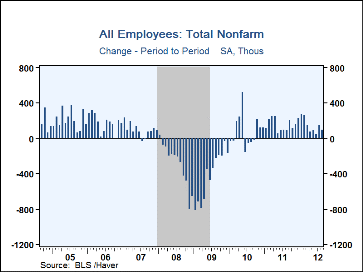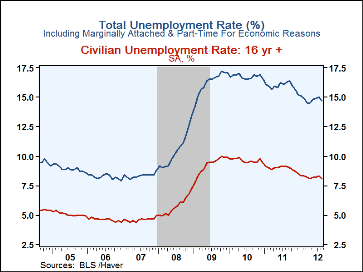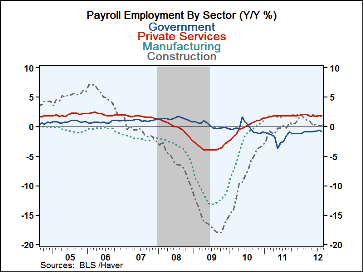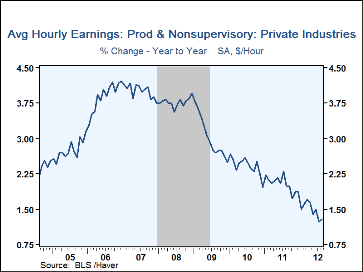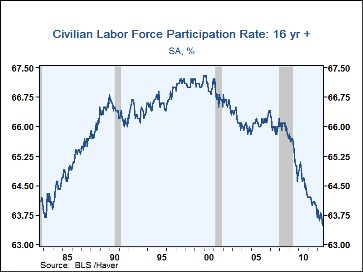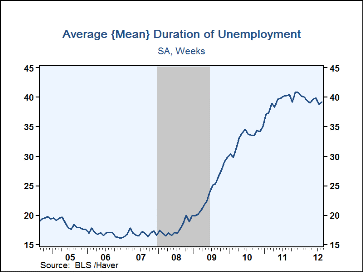 Global| Sep 07 2012
Global| Sep 07 2012U.S. Payroll Gain Is Weak As Unemployment Rate Falls
by:Tom Moeller
|in:Economy in Brief
Summary
The job market is having trouble showing consistent improvement.Nonfarm payrolls grew 96,000 during August following revised changes of 141,000 and 45,000 during the prior two months, earlier reported as 163,000 and 64,000, [...]
The job market is having trouble showing consistent improvement.Nonfarm payrolls grew 96,000 during August following revised changes of 141,000 and 45,000 during the prior two months, earlier reported as 163,000 and 64,000, respectively. A 135,000 increase was expected for August. Disappointing gains in employment were widespread amongst industries. The unemployment rate fell to 8.1% versus expectations for stability at 8.3%.
From the establishment jobs survey, employment growth slowed to 96,000 (1.4% y/y) last month following downwardly revised gains during the prior two months. The average rise so far in Q3 is 118,500 versus 66,667 during Q2 and 226,000 in Q1. Payrolls have risen 3.1% since the February 2010 trough. Last month's weakness was led by a 15,000 decline (+1.7% y/y) in factory sector payrolls. The decline was the first in two years. Construction employment ticked up 1,000 (0.3% y/y); however, declines have been pervasive since February. Private service sector jobs rose a diminished 119,000 (1.9% y/y) led by a 34,000 rise (2.4% y/y) in leisure & hospitality. That was followed by a 29,000 increase (1.2% y/y) in trade, transportation & utilities and a 28,000 gain (3.3% y/y) in professional & business services. Temporary help employment fell 4,000 (+8.9% y/y), weak for the second month after strength since last August. Government employment fell 7,000 (-0.8% y/y) led by a 6,000 decline (-0.7% y/y) in state government jobs and a 4,000 drop (-0.6% y/y) in local government. Federal sector employment rose 3,000 (-1.5% y/y).
Not only have job gains weakened but the breadth of increase has collapsed. The one-month diffusion index of job growth fell to just 50.2% last month, its lowest since February 2010. Over a three month period, the index fell to 54.5, its lowest since March of 2010.
The number of weekly hours worked held at a reduced 34.4 versus the recovery high of 34.6 in February. These figures remained up from 33.8 at the depth of the recession. In the goods sector, the average workweek of 40.0 hours compared to 40.5 at the February peak. The private service sector workweek held for the fifth month at 33.3 hours but was off from its 33.4 hour peak.Aggregate hours worked (employment times hours) ticked up 0.1% (2.0% y/y) and is up at a 0.2% annual rate from Q2.
Average hourly earnings slipped 0.1% (+1.3% y/y) and reversed the prior month's uptick.
From the household employment survey, the unemployment rate fell to 8.1%, its lowest since January 2009. The decline reflected a 119,000 drop (+1.7% y/y) in employment that was exceeded by a 368,000 decline (+0.6% y/y) in the labor force. That lower labor force reflected a reduced participation rate of 63.5% of the eligible population, the lowest since September 1981. The total unemployment rate including those who are marginally attached & part time for economic reasons fell to 14.7%. The average duration of unemployment rose m/m to 39.2 weeks compared to 40.3 one year ago. The number of persons unemployed for 52 weeks or longer fell 18.9% y/y.
Education pays off. The unemployment rate for individuals without a high school diploma was 12.0%. For those with one but no college it was 8.8%. For individuals with some college but no diploma the rate was 6.6% and for college graduates or higher it was 4.1%.
The figures referenced above are available in Haver's USECON database. Additional detail can be found in the LABOR and in the EMPL databases. The expectation figures are from Action Economics and are in the AS1REPNA database.
The Economics of Household Leveraging and Deleveraging from the Federal Reserve Bank of Philadelphia is available here.
| Employment: (M/M Chg., 000s) | Aug | Jul | Jun | Y/Y | 2011 | 2010 | 2009 |
|---|---|---|---|---|---|---|---|
| Payroll Employment | 96 | 141 | 45 | 1.4% | 1.2% | -0.7% | -4.4% |
| Previous | -- | 163 | 64 | -- | -- | -- | -- |
| Manufacturing | -15 | 23 | 7 | 1.7 | 1.8 | -2.7 | -11.6 |
| Construction | 1 | 0 | 4 | 0.3 | -0.3 | -8.2 | -16.0 |
| Private Service Producing | 119 | 139 | 54 | 1.9 | 1.8 | -0.1 | -3.5 |
| Government | -7 | -21 | -18 | -0.8 | -1.7 | -0.3 | 0.2 |
| Average Weekly Hours - Private Sector | 34.4 | 34.4 | 34.5 | 34.3 (Aug'11) |
34.4 | 34.1 | 33.9 |
| Average Private Sector Hourly Earnings (%) | -0.1 | 0.1 | 0.2 | 1.3 | 2.0 | 2.4 | 3.0 |
| Unemployment Rate (%) | 8.1 | 8.3 | 8.2 | 9.1 (Aug'11) |
9.0 | 9.6 | 9.3 |
Tom Moeller
AuthorMore in Author Profile »Prior to joining Haver Analytics in 2000, Mr. Moeller worked as the Economist at Chancellor Capital Management from 1985 to 1999. There, he developed comprehensive economic forecasts and interpreted economic data for equity and fixed income portfolio managers. Also at Chancellor, Mr. Moeller worked as an equity analyst and was responsible for researching and rating companies in the economically sensitive automobile and housing industries for investment in Chancellor’s equity portfolio. Prior to joining Chancellor, Mr. Moeller was an Economist at Citibank from 1979 to 1984. He also analyzed pricing behavior in the metals industry for the Council on Wage and Price Stability in Washington, D.C. In 1999, Mr. Moeller received the award for most accurate forecast from the Forecasters' Club of New York. From 1990 to 1992 he was President of the New York Association for Business Economists. Mr. Moeller earned an M.B.A. in Finance from Fordham University, where he graduated in 1987. He holds a Bachelor of Arts in Economics from George Washington University.


